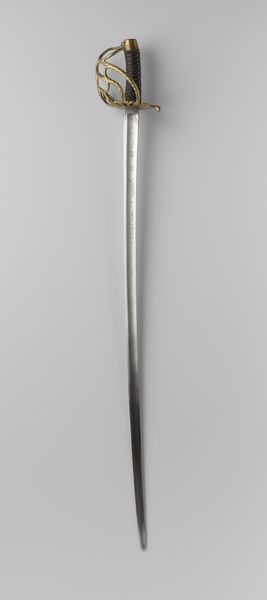
Onderstok van parasol of parapluie van hout met knop van been c. 1920 - 1940
0:00
0:00
gustavschnitzler
Rijksmuseum
wood
#
line
#
wood
Dimensions: width 5 cm, length 64 cm
Copyright: Rijks Museum: Open Domain
Curator: It’s remarkably understated, isn’t it? A simple curve. It almost has the character of an antique fishing rod or something similar, doesn't it? Editor: Well, let’s unpack that simplicity. What we have here is what’s described as the bottom piece of a parasol or umbrella made of wood with a bone knob, dating roughly between 1920 and 1940. It resides here at the Rijksmuseum. The linearity is its most striking aspect, especially given its association with protection and perhaps even class status during that period. Curator: That bone knob especially intrigues me, a sign of gentle luxury! Do we know about the object’s owners, or how such a quotidian item came to be considered museum-worthy? Editor: That is where things get interesting! There are limited records for this object’s early ownership or usage, sadly, which also makes it fascinating. We do have records that suggest that by examining trends in parasol and umbrella designs through a sociological lens we can perhaps unlock insight into evolving social codes and the changing roles and status of women during that time. Curator: Ah, precisely! So this slender object whispers narratives of social history, hinting at changing gender roles and accessibility. We can see here a direct lineage to power through class display, by what materials are used and the aesthetic values that these choices promote. Editor: Absolutely, consider too how weather and climate shape society, where things like parasols and umbrellas literally shade societal structure from meteorological patterns, thus allowing different freedoms to the owner than one might think about. The way we understand its functionality is really interesting in how that understanding is framed, historically! Curator: It's curious how such a simple object reflects complex social forces. Perhaps we read more into it with distance? I still think it makes a marvelous fishing rod! Editor: Well, with objects like this there is the potential to create further public dialogue in understanding this, it is more an invitation to examine assumptions about historical relevance than simply viewing what we see.
Comments
No comments
Be the first to comment and join the conversation on the ultimate creative platform.













